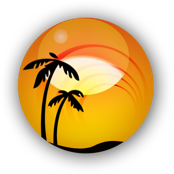“Go sailing now my friend,
it is later than you think”


“Go sailing now my friend,
it is later than you think”
Charter Bahia de Banderas
"Bahia de Banderas", or "Bay of Flags". The bay has over 40 miles of coast and numerous beaches. Below the warm, tranquil waters of the Bahía de Banderas is a world of stingrays, tropical fish and garishly colored corals. Great spots for diving and snorkeling are Los Arcos, the rocky islands south of the city center, and the Islas Marietas, which are surrounded by reefs, tunnels, walls and underwater caves. Dolphins, whales and giant manta rays are often sighted between December and April.
Yalapa
Marginal fair weather stop open to N. Marginal holding. Coarse sand beach. Steven grew up here and went to the local school in the village in ’68. Yalapa was probably first populated by a some Native Americans of the tribe that originated in the ancient circular town of Tenacatitlan, 100 miles north, as they migrated south to eventually form Mexico City and become the Aztec empire. The word means 'gathering place' or 'meeting place' and, although it lies on the same latitude as Hawaii, has been likened to Tahiti.
The road south of Puerto Vallarta does not go all the way around the bay but cuts inland at Boca de Tomatlan. To get to Yelapa you must take a boat from Boca de Tomatlan , Los Muertos beach or the beach just south of the Rosita Hotel. Yelapa can also be reached by mountain bike or hiking down from El Tuito, high in the mountains behind the village. There is a daily cruise boat that drops tourists off for about two hours.
Raicilla, pronounced "rye-see-ya", is the local moon shine. It is distilled in crude, primitive stills from a fermented mash made from the roots ( raicilla means "little root" ) of the maguey plant. It is a strong violent liquor of greatly varying quality, and usually more than 100 proof. Since it is produced without government license, and sold without government tax, it is illegal in the same sense that moonshine is illegal in the United States. Its production is one of the traditional local arts, and it is found only in this area.
Since it is higher in alcoholic content than most commercially available liquors even a small amount can produce a sudden, strong, and unpredictable drunkeness. There are many reports of violent gastric reactions, and temporary motor paralysis. It has a strong, and persistent reputation for producing an aphrodisiac effect in women, but causing temporary impotency in men. This can lead to a social situation of confused, and conflicting desires. It gives a rough hangover.
The myth that it produces a psychedelic effect is a product of a raicilla-inflamed imagination. The myth is based (insofar as it is based on anything at all ) on the mistaken belief that it contains mescaline from the local San Pedro cactus. Although the San Pedro cactus does contain some mescaline and has, at times, been used as part of the fermented mash, the chemical mescaline is not volatile ( it crystallizes rather than vaporizes ) and so cannot go through the distillation process, but remains a residue in the mash.
Raicilla can be tested for alcohol content by pouring a bit in a saucer and lighting a match to the rising vapor. If it burns it is of high proof, and probably has not been watered down.
Since raicilla is cheap, strong, and readily available, it is most widely and frequently used drinks among the local borrachos (drunks). The raicilla-borracho can still sit and talk ( lucidly, he thinks ) long after he has lost the ability to walk. He does not know this until after he stands up.
For those who drink alcohol at all, a taste of raicilla is an almost essential part of the full local experience. When you drink it for the first time, you should be in secure surroundings among people you know and trust and use cautious moderation.
Puerto Vallarta
Is known as Mexico's "Riviera", where people can have the best of both worlds -- whether you come here for a vacation, or for a longer period of time. It is at the center of - the "Bahia de Banderas", or "Bay of Flags". The bay has over 40 miles of coast and numerous beaches.
It is fast becoming one of the world's most popular travel destinations is because it offers a unique blend of traditional, "Old Mexico" charm mixed with the modern amenities of a cosmopolitan setting. There are cobblestone streets and old Spanish-colonial style white stucco houses with red clay tile roofs. The sound of church bells, roosters crowing, and the clatter of donkeys' hooves on the cobblestones continues to be an everyday occurrence, just as it was 150 years ago.
There are 345 days of sunshine each year, with average daytime temperatures reaching into the high 80's. At night, there is an onshore breeze from the Bay ,bringing cool air and cool night temperatures that make for pleasant sleeping conditions - without air conditioners.
Marina Riviera Nayarit
Marina is top notch. Has a very good summer rate if you are planned to stay during the hurricane season.
Good bus service to downtown Puerto Vallarata.
Punta de Mita
Lovely anchorage, a safe spot in all but southerlies- just inside Bahia Banderas.
Chacala (in Nayarit) is a sleepy fishing village located 26 miles south of the popular cruiser stop of San Blas, and north of Banderas Bay, Mexico. Popular with Mexican tourists especially during Semana Santa. Although it's a roadstead anchorage, it is a devine place with friendly Port Captain, large selection of beach-side palapa restaurants and a great little cafe owned by a Northern California woman and her Mexican Husband.
Stay clear of the rocky point to the north. Anchor just off-shore, and clear of the breakers. Be sure to use a stern anchor to keep you into the waves.
There are plenty of new services, B-and-B's, stores and the amazing Mar de Jade Wellness/Yoga Retreat and Spa which is located on the south end of the beach. Walk through the premises to find the trail up the volcano for great views.
This is a very nice place to anchor, but must put out a stern anchor as there is no swing room with other boats.
Don't forget to climb up to the volcano on the south side of the bay. The view is great and the cauldera in very interesting.
San Blas
Lots of history here. Go to the old fort and take the river trip to the old swimming hole. Beware the crooks. Watch for bugs and current. A small fishing village 20 miles north of Santa Cruz, has a variety of attractions such as beaches, colonial architecture, history, many species of exotic birds, a thick tropical jungle, estuaries and a navigable river. It was was an important Spanish port from the late 16th to the 19th century.





